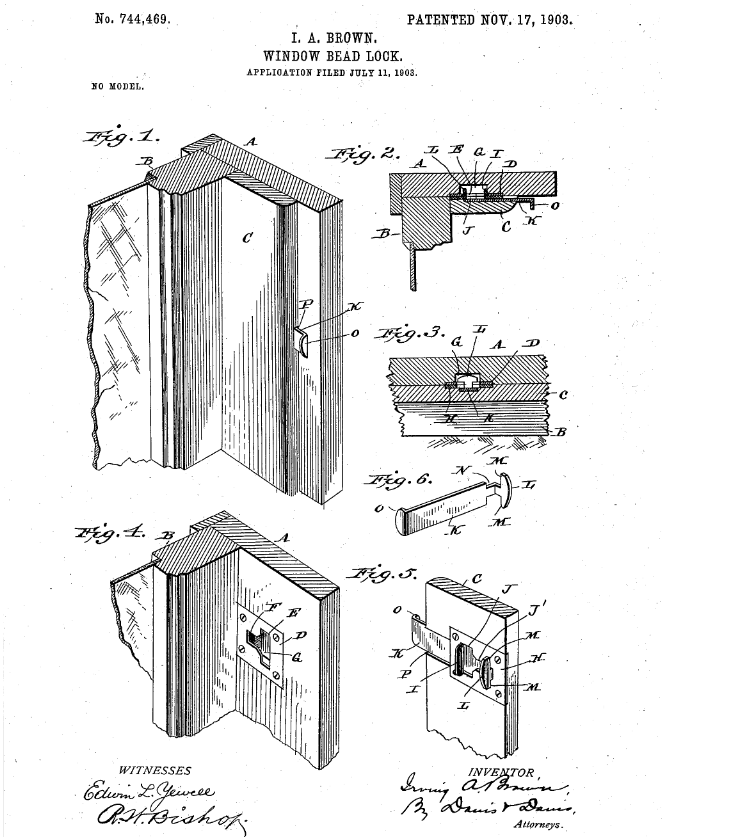IRVING A. BROWN, OF ALLEGAN, MICHIGAN
WINDOW-BEAD LOCK.
SPECIFICATION forming part of Letters Patent No. 744,469, dated November 17, 1903
Application filed July 11, 1903.
Serial No. 165,165. (No model.)
To all whom it may concern:
Be it known that I, IRVING A. BROWN, a citizen of the United States,
residing at Allegan, county of Allegan, State of Michigan, have invented certain new and useful Improvements in
Window-Bead Locks, of which the following is a specification, reference being had therein to the accompanying
drawings, in which--
Figure 1 is a perspective view of a portion of a window frame and sash, showing
the bead
locked in position; Fig.2, a horizontal sectional view thereof, showing the locking means; Fig. 3, a
vertical sectional view; Fig. 4, a perspective view of portions of the window - frame and a sash, the bead being
removed; Fig. 5, a detail perspective view of a portion of the bead, showing the locking means on the inside thereof;
and Fig. 6, a detail perspective view of the movable locking-bolt.
This invention has for its main
object to provide a simple device for detachably locking the bead to the window-frame, whereby the use of the usual
nails or screws, which are passed or driven through the bead into the window-frame, is avoided.
Referring
to the various parts by letters, A designates the window-frame, B the window-sash, and C the vertical bead or strip,
which is secured to the window-frame to hold the inner sash in position, one edge of said strip bearing lightly
against the inner side of the sash.
Secured to the side of the window-frame at a suitable point and in
such position as to be covered by the sash-retaining bead C when the same is in position is a plate D. This plate
is set in a frame so that its outer face is flush wiht the inner face of the frame, and is formed with the vertical
slot or opening E, from which extends inward the narrow horizontal slot F, said slot connecting with the slot E
midway the ends of the latter slot, the two slots forming a substantially T-shaped opening in the plate. The
frame back of the opening in the plate D is cut away to form the recess G.
Secured to the inner side of
the retaining bead C in such position as to overlie the plate D, secured to the frame, when the said bead is secured
in position, is a plate H, said plate being set in the bead so that its outer face is flush with the surface of said
bead. This plate is formed with a rigid outward-extending vertical stop I, which when the bead C is in position
contacts with the outer wall of the vertical slot E of the plate D and holds the bead C close to the sash and prevents
any outward movement of said bead away from the sash. In the bead C, near the plate H, is formed a horizontal groove
P, in which slides a locking-plate K, a T-shaped locking-head L being formed on the inner end of said plate,
said head extending outward through a vertical slot J, formed in plate H. Extending forward from slot J is a narrow
slot J', this latter slot being connected to slot J about midway the ends of said slot and being sufficiently wide
to permit the narrow shank N, which connects the head L to the sliding plate K, to be moved forward into it. On the
outer end of the locking-bolt K is formed a laterally-projecting finger-piece O, by means of which the sliding
locking-plate may be manipulated.
When the retaining-bead is to be placed in position, the locking-bolt
is pulled outward until the head L contacts with the stop I. The bead C may then be placed in position, the stop I
and the head L passing through the aperture E in plate D. Sliding bolt K is then forced inward, causing the shank N
to pass into the narrow part J' and F of the plate H and D, the parts M of the head L engaging plate D, and thereby
locking the bead C against the window-frame and preventing it moving therefrom in a plane parallel to the plane of
the glass. When it is desired to remove the retaining-bead, it is simply necessary to thrrow outward the locking
bolt or plate K to release the head L from the plate G. (more information available on the patent application)
In testimony whereof I hereunto affix my signature, in the presence of two witnesses, this 11th day
of July, 1903.IRVING A. BROWN
Witnesses:
I. C. MONTAGUE,
LOUIS L. THOMPSON.
|
 Click to enlarge
Click to enlarge
image from patent
application |




 Return
To Home Page
Return
To Home Page
